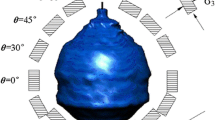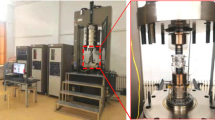Abstract
A large number of salt caverns by solution mining are abandoned widely. After reasonable reformation, some of these caverns are expected to store energies, such as petroleum, natural gas, and compressed air energy. Different from other countries, salt formations of China are mainly bedded with lower thickness. In order to improve the mining efficiency of bedded salt formations, solution mining with double-well convection is widely adopted, which brings more horizontal caverns with larger dimensions and also larger roofs. When these horizontal caverns are transformed into underground energy storage, the layered roofs are easily suffered from unbalanced deformation and failure, and then become the channels of oil or gas leakage. Therefore, a series of theoretical analysis and numerical simulation were carried out to reveal the failure mechanism and stability of the bedded roof, and then some meaningful conclusions are acquired. Firstly, in the overlying strata, the argillaceous anhydrite layer is the key roof in the selection of the abandoned horizontal cavern for energy storage. Secondly, according to plate theory, the invalid of the bedded key roof needs to be treated into failure and instability respectively. Thirdly, the analysis on the vertical and horizontal stress in the key roof shows that it does experience a second type of instability. Finally, in order to maintain the stability of bedded key roof, the main influence factors require careful and comprehensive consideration, including the length of the long side, the thickness of the protective salt layer, and the internal pressure.















Similar content being viewed by others
References
Andargoli MBE, Shahriar K, Ramezanzadeh A, Goshtasbi K (2019) The analysis of dates obtained from long-term creep tests to determine creep coefficients of rock salt. Bull Eng Geol Environ 78(3):1617–1629
Bauer S, Ehgartner B, Levin B, Linn JK (1998) Waste disposal in horizontal solution mined caverns considerations of site location, cavern stability, and development considerations. In: Proc 1998 SMRI fall meeting, Roma, Italy, pp 1–20
Bekendam R, Paar W (2002) Induction of subsidence by brine removal. In: In: Proc 2002 SMRI fall meeting. Bad Ischl, Austria, pp 145–149
Bérest P, Brouard B (2003) Safety of salt caverns used for underground storage blow out; mechanical instability; seepage; cavern abandonment. Oil Gas Sci Technol 58(3):361–384
Bérest P, Bergues J, Brouard B, Durup JG, Guerber B (2001) A salt cavern abandonment test. Int J Rock Mech Min Sci 38(3):357–368
Bruno MS, Dusseault MB (2002) Geomechanical analysis of pressure limits for thin bedded salt caverns. In: In: Proc 2002 SMRI spring meeting. Banff, Alberta, pp 1–25
Cała M, Jakóbczyk J, Cyran K (2017) Application of geotechnical monitoring tools for deformation analysis in the vicinity of the Dębina salt dome (Bełchatów mine, Poland). Eng Geol 230:130–141
DeVries KL, Mellegard KD, Callahan GD, Goodman WM (2005) Cavern roof stability for natural gas storage in bedded salt. RESPEC, Rapid City
Garcia-Fernandez CC, Gonzalez-Nicieza C, Alvarez-Fernandez MI, Gutierrez-Moizant RA (2019) New methodology for estimating the shear strength of layering in slate by using the Brazilian test. Bull Eng Geol Environ 78(4):2283–2297
Gemmer L, Ings SJ, Medvedev S, Beaumont C (2004) Salt tectonics driven by differential sediment loading: stability analysis and finite-element experiments. Basin Res 16(2):199–218
Han CL, Zhang N, Ran Z, Gao R, Yang HQ (2018) Superposed disturbance mechanism of sequential overlying strata collapse for gob-side entry retaining and corresponding control strategies. J Cent South Univ 25(9):2258–2271
Hudec MR, Jackson MPA (2007) Terra infirma: understanding salt tectonics. Earth Sci Rev 82(1–2):1–28
Jiang DY, Ren S, Liu XR, Liu BX (2005) Stability analysis of rock salt cavern with catastrophe theory. Rock Soil Mech 26(7):1099–1103 (in Chinese)
Kang HP, Lou JF, Gao FQ, Yang JH, Li JZ (2018) A physical and numerical investigation of sudden massive roof collapse during longwall coal retreat mining. Int J Coal Geol 188:25–36
Kunstmann AS, Urbanczyk KM (1995) Modelling of horizontal cavern leaching: main aspects and perspectives. In: Proceedings of SMRI Fall 1995 Meeting, San Antonio, USA, pp 1–18
Liang WG, Yang CH, Zhao YS (2008) Physico-mechanical properties and limit operation pressure of gas deposit in bedded salt rock. Chin J Rock Mech Eng 27(1):22–27 (in Chinese)
Liu W, Li YP, Yang CH, Daemen JJK, Yang Y, Zhang GM (2015) Permeability characteristics of mudstone cap rock and interlayers in bedded salt formations and tightness assessment for underground gas storage caverns. Eng Geol 193:212–223
Liu W, Chen J, Jiang DY, Shi XL, Li YP, Daemen JJK, Yang CH (2016) Tightness and suitability evaluation of abandoned salt caverns served as hydrocarbon energies storage under adverse geological conditions (AGC). Appl Energy 178:703–720
Liu W, Jiang DY, Chen J, Daemen JJK, Tang K, Wu F (2018) Comprehensive feasibility study of two-well-horizontal caverns for natural gas storage in thinly-bedded salt rocks in China. Energy 143:1006–1019
Liu W, Zhang ZX, Chen J, Fan JY, Jiang DY, Daemen JJK (2019) Physical simulation of construction and control of two butted-well horizontal cavern energy storage using large molded rock salt specimens. Energy 185:682–694
Qian MG, He FL (1991) Behaviour of the main roof in longwall mining - weighting span, fracture and disturbance. Int J Rock Mech Min Sci 1991 28(1):A53
Qian MG, Xu JL (1998) Study on the “O-Shape" circle distribution characteristics of mining-induced fractures in the overlaying strata. J China Coal Soc 23(5):466–469
Qian MG, Shi PW, Xu JL (2010) Mining pressure and strata control. Xuzhou: China University of Mining and Technology Press
Singh A, Kumar C, Kannan LG, Rao KS, Ayothiraman R (2018) Engineering properties of rock salt and simplified closed-form deformation solution for circular opening in rock salt under the true triaxial stress state. Eng Geol 243:218–230
Talbot CJ, Jackson MPA (1988) Salt tectonics. Sci Am 257(1):111–112
Thoms RL, Gehle RM (1993) Feasibility of controlled solution mining from horizontal wells. In: Proceedings of SMRI Fall 1993 Meeting, Louisiana, USA, pp 1–9
Van Thienen-Visser K, Hendriks D, Marsman A, Nepveu M, Groenenberg R, Wildenborg T, van Duijne H, den Hartogh M, Pinkse T (2014) Bow-tie risk assessment combining causes and effects applied to gas oil storage in an abandoned salt cavern. Eng Geol 168:149–166
Wang ZT, Qian MG (1989) The calcualting methods of the first weighting span of main roof. J China Uni Min Tech 18(2):9–18
Wang TT, Yang CH, Shi XL, Ma HL, Li YP, Yang Y, Daemen JJK (2015) Failure analysis of thick interlayer from leaching of bedded salt caverns. Int J Rock Mech Min Sci 73:175–183
Wang TT, Yang CH, Chen JS, Daemon JJK (2018) Geomechanical investigation of roof failure of China’s first gas storage salt cavern. Eng Geol 243:59–69
Winn K, Wong LNY, Alejano LR (2019) Multi-approach stability analyses of large caverns excavated in low-angled bedded sedimentary rock masses in Singapore. Eng Geol 259:105164
Xing W, Zhao J, Hou ZM, Were P, Li MY, Wang G (2015) Horizontal natural gas caverns in thin-bedded rock salt formations. Environ Earth Sci 73(11):6973–6985
Yang CH, Jing WJ, Daemon JJK, Zhang GM, Du C (2013) Analysis of major risks associated with hydrocarbon storage caverns in bedded salt rock. Reliab Eng Syst Saf 113:94–111
Yang CH, Wang TT, Li YP, Yang HJ, Li JJ, Qu DA, Xu BC, Yang Y, Daemen JJK (2015) Feasibility analysis of using abandoned salt caverns for large-scale underground energy storage in China. Appl Energy 137:467–481
Yang CH, Wang TT, Ma H, Li YP, Shi XL, Daemen JJK (2016) Feasibility analysis of using horizontal caverns for underground gas storage: a case study of Yunying salt district. J Nat Gas Sci Eng 36:252–266
Zhang GM, Li YP, Yang CH, Daemen JJK (2014) Stability and tightness evaluation of bedded rock salt formations for underground gas/oil storage. Acta Geotech 9(1):161–179
Zhang GM, Li YP, Daemen JJK, Yang CH, Wu Y, Zhang K, Chen YL (2015a) Geotechnical feasibility analysis of compressed air energy storage (CAES) in bedded salt formations in Huai’an city, China. Rock Mech Rock Eng 48(5):2111–2127
Zhang GM, Wu Y, Wang LJ, Zhang K, Daemen JJK, Liu W (2015b) Time-dependent subsidence prediction model and influence factor analysis for underground gas storages in bedded salt formations. Eng Geol 187:156–169
Zhang GM, Wang LJ, Wu Y, Li YP, Yu SY (2017) Failure mechanism of bedded salt formations surrounding salt caverns for underground gas storage. Bull Eng Geol Environ 76(4):1609–1625
Zhang GM, Wang ZS, Zhang K, Li YP, Wu Y, Chen YL, Zhang HQ (2018) Collapse mechanism of the overlying strata above a salt cavern by solution mining with double-well convection. Environ Earth Sci 77:588
Zhang GM, Wang ZS, Wang LJ, Chen YL, Wu Y, Ma D, Zhang K (2019a) Mechanism of collapse sinkholes induced by solution mining of salt formations and measures for prediction and prevention. Bull Eng Geol Environ 78(3):1401–1415
Zhang ZX, Jiang DY, Liu W, Chen J, Li ER, Fan JY, Xie KN (2019b) Study on the mechanism of roof collapse and leakage of horizontal cavern in thinly bedded salt rocks. Environ Earth Sci 78(10):292
Acknowledgments
We are grateful to the anonymous reviewers and editors for their constructive comments that greatly improved this manuscript.
Funding
This work was supported by the financial support from the National Natural Science Foundation of China (Grant numbers 41877277, 51504243, 51674247, and 11702094), the Natural Science Foundation of Jiangsu Province (Grant number BK20150191), the Fund of China Scholarship Council (Grant number 201906425005), and the Fundamental Research Funds for the Central Universities (Grant number 2015XKZD06).
Author information
Authors and Affiliations
Corresponding author
Rights and permissions
About this article
Cite this article
Zhang, G., Wang, Z., Liu, J. et al. Stability of the bedded key roof above abandoned horizontal salt cavern used for underground gas storage. Bull Eng Geol Environ 79, 4205–4219 (2020). https://doi.org/10.1007/s10064-020-01830-x
Received:
Accepted:
Published:
Issue Date:
DOI: https://doi.org/10.1007/s10064-020-01830-x




